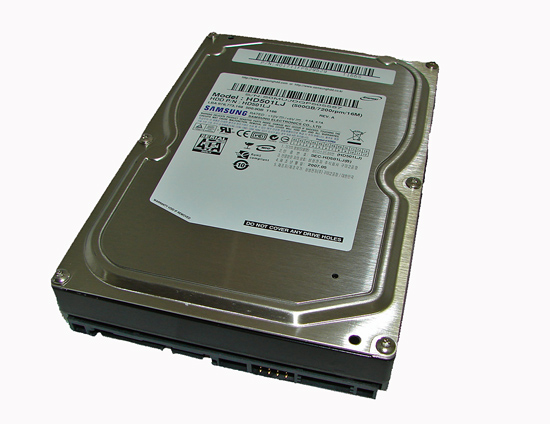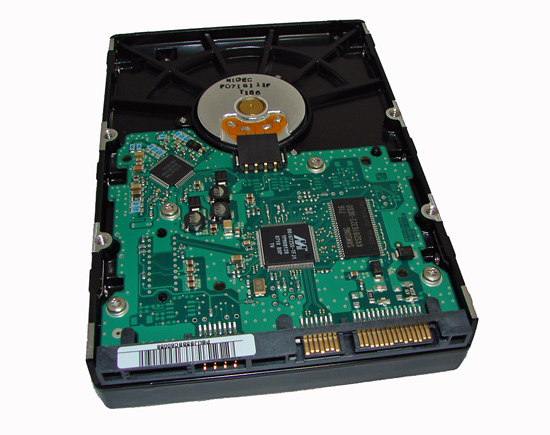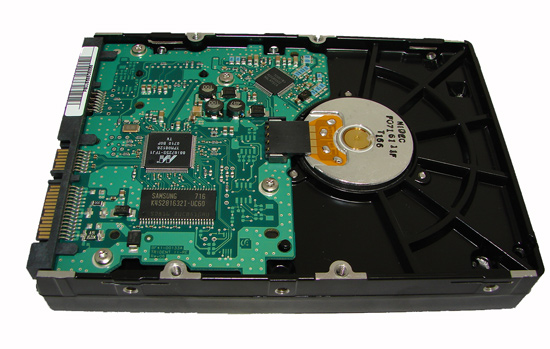Samsung SpinPoint T166 500GB: Cool, Quiet, and Quick
by Gary Key on July 9, 2007 2:00 AM EST- Posted in
- Storage
Drive Specifications
When compared directly to two of its competitors within the 500GB category, we find the Samsung HD501LJ has nearly identical specs as the Hitachi and Seagate drives. The only major differences is a read seek time advantage and lower power consumption at idle for the Hitachi drive and an additional two years of warranty coverage for the Seagate drive.
Samsung has 17 variations of the T166 product series released at this time with a choice of PATA or SATA interfaces and 8MB or 16MB cache schemes. Capacities for the T166 series range from 80GB to 500GB. Our review unit is at the top of Samsung's model lineup with a 500GB capacity and SATA 3Gbps interface. This capacity is made possible by three 167GB platters spinning at 7200rpm with a 16MB cache. The current street price for this unit is around $109 making it a bargain in the 500GB market. The Hitachi and Seagate drives sell for $139 and $119 respectively.
Feature Set

The external casing design of the SpinPoint T166 series is based on the industry standard 3.5" form factor platform with pertinent part number and warranty information embossed on a white sticker on the top of the casing. Samsung quotes a 600,000 hour Mean Time Between Failure rate that is significantly less than other drives in this category, and near-line enterprise SATA drives that hover around a 1 million to 1.2 million hour MTBF rating.
Of course, MTBF ratings are meaningless if your drive fails within a few hours of operation or a few days outside the warranty period, as is known to happen on occasion. We normally pay very little attention to MTBF ratings and instead focus on the manufacturer's stated lifetime expectancy for the drive and warranty coverage - the longer the better. Samsung lists the life expectancy of this drive under normal operating conditions to be around five years and provides a three year warranty.

The SpinPoint T166 SATA family ships with Serial ATA data and power connectors only. There is no support for the 4-pin Molex power connector designed for use with older ATX power supplies. To the left of the data and power connectors is an eight pin jumper block. This jumper block will determine whether the drive operates in Master, Slave, or Select Cable mode if you are using a PATA model; for SATA models this jumper block has no effect.
The PCB is openly visible on the bottom of the drive as in previous series and contains a Marvell controller chipset and Samsung's own memory module. In the past we have seen Samsung utilize ESMT (Elite Semiconductor Memory Technology) memory which was always surprising given the size of Samsung's memory business.
| Drive Specifications | |||
| Samsung SpinPoint T166 500GB HD501LJ |
Hitachi Deskstar T7K500 500GB HDT725050VLA360 |
Seagate Barracuda 7200.10 500GB ST3500630AS |
|
| Manufacturer's Stated Capacity | 500GB | 500GB | 500GB |
| Operating System Stated Capacity | 465.8 GB | 465.8 GB | 465.8 GB |
| Interface | SATA 3Gb/s | SATA 3Gb/s | SATA 3Gb/s |
| Rotational Speed | 7,200 RPM | 7,200 RPM | 7,200 RPM |
| Cache Size | 16 MB | 16 MB | 16 MB |
| Average Latency | 4.17 ms (nominal) | 4.17 ms (nominal) | 4.16 ms (nominal) |
| Read Seek Time | 8.9 ms | 8.5 ms | 11 ms |
| Number of Heads | 6 | 6 | 6 |
| Number of Platters | 3 | 3 | 3 |
| Power Draw Idle / Load |
7.1W / 11.3W | 6.9W / 12.5W | 8.6W / 12.6W |
| Command Queuing | Native Command Queuing | Native Command Queuing | Native Command Queuing |
| Warranty | 3 Year - Retail or OEM | 3 Year - Retail or OEM | 5 Year - Retail or OEM |
When compared directly to two of its competitors within the 500GB category, we find the Samsung HD501LJ has nearly identical specs as the Hitachi and Seagate drives. The only major differences is a read seek time advantage and lower power consumption at idle for the Hitachi drive and an additional two years of warranty coverage for the Seagate drive.
Samsung has 17 variations of the T166 product series released at this time with a choice of PATA or SATA interfaces and 8MB or 16MB cache schemes. Capacities for the T166 series range from 80GB to 500GB. Our review unit is at the top of Samsung's model lineup with a 500GB capacity and SATA 3Gbps interface. This capacity is made possible by three 167GB platters spinning at 7200rpm with a 16MB cache. The current street price for this unit is around $109 making it a bargain in the 500GB market. The Hitachi and Seagate drives sell for $139 and $119 respectively.
Feature Set

The external casing design of the SpinPoint T166 series is based on the industry standard 3.5" form factor platform with pertinent part number and warranty information embossed on a white sticker on the top of the casing. Samsung quotes a 600,000 hour Mean Time Between Failure rate that is significantly less than other drives in this category, and near-line enterprise SATA drives that hover around a 1 million to 1.2 million hour MTBF rating.
Of course, MTBF ratings are meaningless if your drive fails within a few hours of operation or a few days outside the warranty period, as is known to happen on occasion. We normally pay very little attention to MTBF ratings and instead focus on the manufacturer's stated lifetime expectancy for the drive and warranty coverage - the longer the better. Samsung lists the life expectancy of this drive under normal operating conditions to be around five years and provides a three year warranty.

The SpinPoint T166 SATA family ships with Serial ATA data and power connectors only. There is no support for the 4-pin Molex power connector designed for use with older ATX power supplies. To the left of the data and power connectors is an eight pin jumper block. This jumper block will determine whether the drive operates in Master, Slave, or Select Cable mode if you are using a PATA model; for SATA models this jumper block has no effect.
 |
| Click to enlarge |
The PCB is openly visible on the bottom of the drive as in previous series and contains a Marvell controller chipset and Samsung's own memory module. In the past we have seen Samsung utilize ESMT (Elite Semiconductor Memory Technology) memory which was always surprising given the size of Samsung's memory business.










42 Comments
View All Comments
8steve8 - Sunday, July 15, 2007 - link
ive had 2 of these drives for 8 months now,, so the review seems late.obviously the new samsung 1TB 3platter drives are immensly interesting.
the specs and samsungs history in this market makes it seem to be the drive to have in the next 12 months.
natebsi - Wednesday, July 11, 2007 - link
I've purchased 3 of these drives, and 2 have failed in about 4 months time. One was in my pc, the other was in an external enclosure. (The one still working is in my HTPC).2 out of 3 failures in such a short time is pretty bad.
However... the reason I won't be buying any more Samsung drives is not because they failed, but because they don't have an advance replacement program. That was fairly shocking to me! I took it for granted after sending it failed drives to Maxtor and WD (both of whom have outstanding service when it comes to that, BTW).
Hard drive failures are a given, and I can't deal with that. A drive failure is too critical a problem to wait for a replacement more than a couple days. In my opinion anyway...
Final Hamlet - Thursday, July 12, 2007 - link
Backup + cooling = No need to worry.I remember having a 20gb Western Digital Caviar, which did me the favour of giving me a special sign that it had come near the end of it's life, so I could replace it in time. If only all HDs could issue that kind of warning...
TA152H - Wednesday, July 11, 2007 - link
Oh boy. Useful to know this. I guess I will wait to buy them.You're a lot more forgiving than I am. I really hate hard drive failures, because they take so long to recover from. It's the worst type of failure in my opinion. And also, because I'm stupid and go a few days without doing a proper backup sometimes. So, for hard disks, I value reliability more than any other part (except maybe the power supply, which tends to screw up a lot of things further down the food chain).
The replacement policy shows that Samsung doesn't quite get it. They don't seem to understand how important reliability is, or how important it is to get someone up and running again as quickly as possible. I always carry a spare or two if it's for a RAID array, but Samsung is selling these to residential people too, and no one likes being without their computer, and they aren't going to keep spare hard disks.
natebsi - Thursday, July 12, 2007 - link
It's not that I'm forgiving, its more that I've excepted the fact(or at least high probability) that any hard drive I buy today, from any manufacturer, will fail. Maybe tomorrow, maybe the next day, maybe 5 years from now.So as a consequence, I am extremely diligent about backing up my data. I use both RAID and a backup service from mozy.com for the most important data.
Also, I hear a lot of talk about how "Maxtor sucks!" or "Seagate sucks" or "<insert manufactuer> sucks!". The simple fact of the matter is: Without factual data from the hard drive makers themselves, there will NEVER be any method of determining which hard drive manufacturers are the most reliable. And none of them will ever produce that data for obvious reasons.
Case in point: I've had more hard drives than I can even remember in the last 15+ years, and I truly can't think of "the best manufacturer". Every time I've thought I had a great series of drives, I had failures at some point that made me rethink it. So...... backup, backup, backup, and go with the company that provides the best warranty, service, etc. Which, IMHO, ain't Samsung.
TA152H - Thursday, July 12, 2007 - link
Well, you have some factual data from Seagate, look at their warranty.Hard drives can fail, but I have had none from Seagate fail, and this included drives over 5 years old, actually, some over 10. And this goes back to the ST-255 and ST-251, although you'd have to low level them every few years because they were steppers. Crashtors I never bought, but they were so widely recognized as bad, it was way past anecdotal. IBM's drive problems were also not anecdotal, they were widely publicized and even recognized by IBM. Western Digital's were similar, although I don't remember exactly what Western Digital did to fix it. I had bought two of their drives around that time, and both died as well. So, it's not just people blabbing, some of it is very clearly bigger than that. I have never seen Seagate get into that situation, and they sell a lot of drives.
I actually did have a Seagate fail, but it was some 10K monster made in the 1990s, and it was left in a garage for about three years. I can't really blame it for that, it probably got stepped on and kicked and slept on by a raccoon. But, it worked before it's garage experience. Having used well over 200 Seagate hard drives over the years, just my own, not for a company, that's not a bad success rate, especially since the ones in my main machines I don't change often. The one on this machine is from 2001, and doesn't make a sound and is on 24/7. Try that with a Samsung.
I do agree, back up early and often. I forget to sometimes though, I wish I didn't, but I do. You really have no control over it, it can happen any time, so the only way to address that truly is to make sure the impact of it happening is limited. But, I'm a moron, I don't do it as often as I should, and I just don't seem to be able to get into the habit of it.
Gary Key - Tuesday, July 10, 2007 - link
I am not too impressed with the Hybrid drives and Vista right now. ;) We will have that review up next week.crimson117 - Monday, July 9, 2007 - link
How do I read the full blurb? On the main page, I seebut I can't find anywhere that shows the remainder of the text. It's not anywhere in the article.
crimson117 - Monday, July 9, 2007 - link
I found the whole blurb when I do a search for the article.Frumious1 - Monday, July 9, 2007 - link
If you click on the storage header that will take you to a page where you can see all the intro text for those articles - same goes for the other areas, of course. Not like it really matters much, does it?